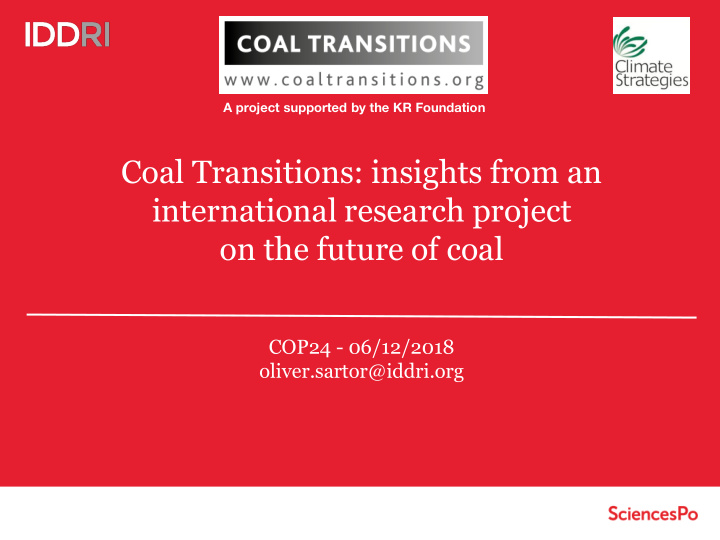



A project supported by the KR Foundation Coal Transitions: insights from an international research project on the future of coal COP24 - 06/12/2018 oliver.sartor@iddri.org
Coal Transitions: an international research project Six leading research teams from 6 major coal using economies: China, India, South Africa, Australia, Germany, Poland. Exploring feasible and just pathways to coal transitions, compatible with <2°C goal of Paris Agreement
Key elements of a coherent strategy 1. (Paris-compatible) transformation of the energy system 2. Avoiding stranded assets 3. Avoiding stranded workers 4. Regional economic transition 5. International dimension (esp. for major exporters/importers) .
Coal transitions are happening 36 governments have pledged to phase out coal before 2030 Other large coal using countries, including Germany, South Africa, Spain, are exploring strategies to phase out coal. Others, such as China, EU, are serious about reducing coal use
But more effort is needed to keep well below 2°C Globally, demand growth has essentially levelled out since 2013, despite big differences in trends across countries. Several factors at play. Global demand will probably go into secular decline from 2020s,.. « Well below 2°C » requires bringing demand down more quickly …
Alternatives to coal power becoming more affordable and reliable Mini-grid and off – grid solutions in India or Africa can be cheaper and more reliable than new coal plant Solutions to variability of renewables are numerous and advancing.
For major economies, technically and economically possible to phase out coal from power and heating E.g. Electricity mix pathways for China..; A key is issue is planning phase down of existing assets (avoiding stranded assets faciliting integration of decarbonised power): If you avoid newbuild today, and apply a manadatory 25-year asset lifetime, many countries could largely avoid stranded assets and be consistent with <2°C goal
Coal phase outs can be economically affordable with the right policy framework Some countries face virtually zero or negative incremental cost to coal power phase out South Africa and Australia for example could exploit and abundant natural RES and aging fleets to phase out by ca. 2040 But key conditions: - Infrastructure development/planning - Broaden portfolio of renewables - Improve power market design - Develop residual dispatchable resources (e.g. storage, hydro, biomass, or other solutions) for remaining load
Just transition for workers, citizens is possible Coal extraction regions often suffer from significant problems (predating climate mitiagation). Climate policy can add to this or it can be an opportunity to take some control of existing trends and manage transition to the future. Solutions must be context specific. Some selected insights… • « Anticipation. Anticipation. Anticipation! » • Facilitate inclusive dialogue on a chosen future for key stakeholders • Be concrete: set a timeline with clear milestones • Differentiated and targeted solutions for different worker types • Jobs transfer programs generally better than retraining. • Regional economic reslience and diversification strategies can succeed over long- term, but solutions depend on economic geography and local competitive advantg • Dedicated governance framework for FF transitions necessary, often to simply ensure companies fulfil their responsibilities, do not hijack process. • Coal transitions raise multi-level governance issues • Invest for the next generation, save money and protect « human capital »
Coal transitions can help achieve other societal goals Cheaper and more reliable Water resource contraints & Indian coal access to power for the energy poor Avoiding local pollution/resource competition, esp for water, air and soil. Better health & more desirable and liveable local environment. Avoided fiscal costs of supporting uncompetitive industry Manage risks to energy system from international coal market
Main conclusions 1. Coal transitions are happening already, but more effort is needed for Paris goals 2. <2°C-compatible coal transitions that ensure energy security and affordable electricity for all are technically and economically feasible. 3. A socially just transition for coal sector workers and citizens of coal producing regions is possible. 4. Coal transitions can help to provide numerous co-benefits for society
CONTACT oliver.sartor@iddri.org IDDRI.ORG
Recommend
More recommend